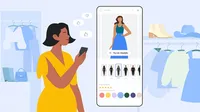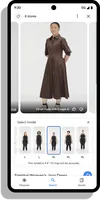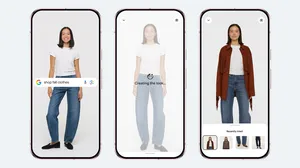Virtually try on dresses with our AI shopping tool

Shopping online to update your seasonal wardrobe can be fun — and challenging. It’s hard to tell how a new style will look on you, and buying something that doesn’t work can send you through the returns process, which is burdensome for both shoppers and retailers. It’s why we launched a virtual try-on tool for women's and men’s tops last year, which uses generative AI to help you see every detail — down to the shadows, wrinkles and draping — of a piece of clothing. Since then, we’ve found that virtual try-on is great for both shoppers and brands. Shoppers spend more time visiting and interacting with these images compared to other shopping images — in fact, virtual try-on images on Search receive 60% more high-quality views, and on average, people try on clothes using four models per product. Shoppers are also more likely to visit a brand’s site after viewing virtual try-on images 1 .
So today, just ahead of the fall season, we’re expanding virtual try-on to another wardrobe staple, and one of the most-searched apparel categories: dresses 2 . You can now better visualize dresses on models that resonate most with you from hundreds of brands across Google’s Shopping Graph — including SIMKHAI, Boden, Staud, Sandro and Maje — in just a few taps.
How it works
If you’re in the U.S, simply search for dresses on Search and click any style that includes a “try on” badge. From there, you can see what that garment looks like on a diverse set of real models, ranging in sizes from XXS-XXXL. Select a model that resonates with you to get a better sense of how the dress looks. Once you find what you’re looking for, click out to the retailer’s site to buy it.
How we built it
This feature is made possible thanks to a generative AI technology we created specifically for virtual try-on (VTO), which uses a technique based on diffusion. Diffusion lets us generate every pixel from scratch to produce high-quality, realistic images of tops and blouses on models. As we tested our diffusion technique for dresses, though, we learned there are two unique challenges: First, dresses are usually a more nuanced garment, and second, dresses tend to cover more of the human body.
Let’s start with the first problem: Dresses are often more detailed than a simple top in their draping, silhouette, length or shape — and include everything from midi-length halters to mini shifts to maxi drop waists — plus everything in between. Imagine you’re trying to paint a detailed dress on a tiny canvas — it’d be hard to squeeze in details like a floral print or ruffled collar onto that small space. Enlarging the image won’t make details clearer, either, because they weren’t even visible in the first place. You can think of our VTO challenge in the same way: Our existing VTO AI model successfully diffused using low-resolution images, but in our testing with dresses, this approach often resulted in the loss of a dress’s critical details — and simply switching to high-resolution didn’t help. So our research team came up with what’s called a “progressive training strategy” for VTO, where diffusion begins with lower-resolution images and gradually trains in higher resolutions during the diffusion process. With this approach, the finer details are reflected, so every pleat and print comes through crystal clear.
Next, since dresses cover more of a person's body than tops, we found that “erasing” and “replacing” the dress on a person would smudge the person's features or obscure important details of their body — much like it would if you were painting a portrait of someone and later tried to erase and replace their dress. To prevent this “identity loss” from happening, we came up with a new technique called the VTO-UNet Diffusion Transformer (VTO-UDiT for short) which isolates and preserves a person’s important features. So while we train the model with “identity loss” in place, VTO-UDiT also gives us a virtual “stencil,” allowing us to re-train the model on only the person, preserving the person’s face and body. This gives us a much more accurate portrayal of not only the dress but just as important, the person wearing it.

How to shop (and try on) the runway
This month in New York, hundreds of brands will be showing dresses from their latest collections on runways across the city. Following ready-to-wear brand SIMKHAI's September show, shoppers will be able to virtually try on select dresses from the collection straight from the runway and pre-order them from SIMKHAI’s site. Just search for SIMKHAI dresses on Google and look for the “try-on” icon to get started. While we’ve partnered with SIMKHAI to help you easily shop looks from New York Fashion Week, you’ll still be able to virtually try on tops and dresses from hundreds of brands across the web — now with more certainty you’ll find something just right.








